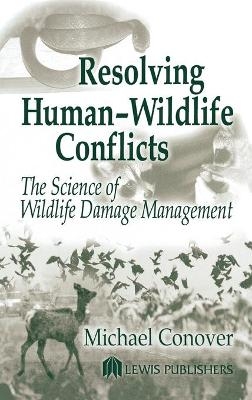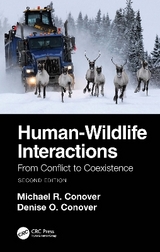
Resolving Human-Wildlife Conflicts
Crc Press Inc (Verlag)
978-1-56670-538-7 (ISBN)
- Titel erscheint in neuer Auflage
- Artikel merken
As more and more people crowd onto less and less land, incidences of human-wildlife conflicts will only increase. A comprehensive overview of this emerging field, Resolving Human-Wildlife Conflicts: The Science of Wildlife Damage Management discusses the issues facing wildlife managers and anyone else dealing with interactions between wildlife and humans. By defining the discipline of wildlife damage management, this book fills a void in the fields of wildlife management and ecology.
The director of the Jack H. Berryman Institute, the only academic institute devoted to wildlife damage management, author Michael Conover is the leader in this field. In this book, he stresses the inter-relatedness of wildlife damage management within the larger discipline of wildlife conservation and provides an extensive review of the scientific literature. He includes case-studies that document how an integrated approach to wildlife management can resolve wildlife-human conflicts.
Nowhere else will you find the authoritative coverage and depth of theoretical information available in Resolving Human-Wildlife Conflicts: The Science of Wildlife Damage Management. The combination of descriptive prose, historical details, and liberal use of informative sidebars add to its appeal as a textbook, while the organization and scope make it the ideal reference for professionals.
Philosophy
Definitions
Philosophies of Wildlife Management
What Positive Values Are Provided by Wildlife?
What Is Wildlife Damage Management?
Why Worry About Human-Wildlife Conflicts?
Contributions of Wildlife Damage Management to the Larger Field of Wildlife Management
Alternative Definitions for Wildlife Damage Management
What Is In a Name?
What Are the Necessary Ingredients for Damage by Wildlife?
The Role of Government in Wildlife Management
The Role of Government Wildlife Biologists
History
Prehistoric Wildlife Management
Wildlife Damage Management in the Ancient World
Wildlife Damage Management in Medieval Europe
Wildlife Management in Colonial America from 1620 to 1776
Wildlife Management in the U.S. from 1776 to 1880
Why the Closing of the Frontier and the Industrial Revolution Sparked a New Philosophy of Wildlife Management
Consequences of the World Wars and the Great Depression on Wildlife Management
Wildlife Management in Modern America
Wildlife Management in the 21st Century: What Now?
Threats to Human Safety
Why Do Animals Attack People?
How Often Are Humans Injured or Killed by Wildlife?
Snakebites
Bear Attacks
Shark Attacks
Alligator Attacks
Attacks by Wolves and Coyotes
Cougar Attacks
Attacks by Large Herbivores
Why Has There Been a Recent Increase in Wildlife Attacks on Humans in North America?
What Can Be Done to Reduce the Frequency of Wildlife Attacks on Humans?
Human Injuries and Fatalities from Ungulate-Automobile Collisions
Human Injuries and Fatalities from Bird-Aircraft Collisions
Zoonoses
Bacterial Diseases
Viral Diseases
Fungal Disease
Economics
Economic Analysis of Wildlife Values
What Are the Sources of Economic Data about the Positive Values of Wildlife?
Why Is It Important to Have Accurate Economic Data about Losses from Wildlife Damage?
Measuring Wildlife Damage by Making a Direct Assessment of Losses
Assessing the Extent of Wildlife Damage by Surveying People
Lost Opportunity Costs
Economic Assessment of Wildlife Damage in the U.S. and Worldwide
Do High Levels of Wildlife Damage Mean that Wildlife Populations Are Too High?
Wildlife Damage to Agricultural Production in Other Parts of the World
Environmental Damage and Exotic Species
What Is An Exotic Species?
Impacts of Exotic Species on the Native Biota
Hawaii
Galapagos Islands
Guam
Australia
North America
Resolving Environmental Problems Caused by Exotic Animals
Can We Predict when an Exotic Species Will Cause Environmental Damage?
Which Sites Are Vulnerable to Exotic Species?
Developing an Integrated Program to Stop the Spread of Exotics
Lethal Control
Intrinsic Growth Rates of Wildlife Populations
What Effect Does Lethal Control have on a Wildlife Population's Birth and Mortality Rates?
What Effect Does Lethal Control have on a Wildlife Population's Immigration Rate?
Is There a Correlation between Wildlife Population Levels and Wildlife Damage?
How Do Values Provided by Wildlife Change as Their Populations Increase?
Should Lethal Techniques Be Directed at specific Individuals, Specific Subpopulations, or the Entire Population?
Are Lethal Methods Legal?
Are Lethal Methods Effective at Reducing Wildlife Damage?
Should Lethal Methods Be Used Ahead of Time to Prevent Wildlife Damage or Only After Damage has Begun?
Are Lethal Techniques Cost Effective?
Do Lethal Techniques Pose a Risk to Nontarget Species?
Are Lethal Techniques Humane and Socially Acceptable?
Common Methods Used in Lethal Control
Fertility Control
Normal Reproductive Function
Mechanical and Surgical Techniques to Reduce Fertility
Reducing Fertility by Disrupting Endocrine Regulation
Immunocontraception
Administering Fertility Drugs to Animals
Controlling the Release of an Antifertility Drug to the Body
When Should We Use Contraception In Wildlife?
Uses of Contraception in Wildlife
Oiling, Addling, or Puncturing Eggs
Efforts in Australia to Resolfe Human-Wildlife Conflicts Using Immunocontraceptives
What are the Drawbacks to Wildlife Contraception?
Public Perceptions of Wildlife Fertility Control
Laws Governing the Use of Fertility Control to Manage Wildlife
Wildlife Translocation
Examples of the Use of Translocation to Resolve Wildlife Conflicts
Do Translocated Animals Return to the Site where They Were Captured?
Do New Animals Replace the Translocated Ones so that the Problem Persists?
Do Translocated Animals Create the Same Problem Elsewhere?
What Happens to Translocated Animals?
What are the Consequences of Translocation on Resident Wildlife Populations?
Is Translocation Cost-Effective?
What are Governmental Policies Concerning the Translocation of Nuisance Animals?
When Is Translocation Warranted?
Fear-Provoking Stimuli
Visula Stimuli
Auditory Stimuli
Olfactory Stimuli
Chemical Stimuli
The Problem of Habituation
Can Habituation to Fear-Provoking Stimuli Be Delayed?
Using Live Predators as Fear-Provoking Stimuli
Using Guard Dogs as Fear-Provoking Stimuli
Hazing or Harassment
Chemical Repellants
How Plants Use Chemicals to Defend Themselves from Herbivores
Biological Basis of Food Preferences
Types of Repellants
Conditioned Food Aversions Based on Deception
Similarities between Batesian Mimicry and DBFA
Factors Influencing Repellant Effectiveness to Reduce Wildlife Damage
Laws Governing the Use of Vertebrate Repellants
Diversion
Optimal Foraging Theory
Large Group Formation as an Antipredator Behavior - A Natural Form of Diversion
Examples of Diversion to Resolve Human-Wildlife Conflicts
Creating a Food Diversion through Habitat Modification
Response of Wildlife to Supplemental Food
Response of Wildlife Diversion
Cost Effectiveness
What Type of Food or Crop Should Be Used in Diversion?
Where Should a Feeder Station or Diversion Crop be Located?
Can Wildlife Damage and the Effectiveness of Diversion Be Predicted?
Which are Better, Diversionary Crops or Feeder Stations?
Can Diversion Be Used with Other Techniques?
Exclusion
Factors Influencing the Cost Effectiveness of Fencing to Reduce Wildlife Damage
Fences to Exclude Deer
Using Fences to Reduce Predation on Livestock
Using Exclusion to Reduce Predation on Nesting Birds
Using Barriers to Protect Individual trees from Herbivores
Exclusionary Devices to Prevent Beaver from Rebuilding Dams
Using a Trap-Barrier System to Reduce Rat Damage in Rice Fields
Using Exclusion to Solve Bird Damage
Excluding Wildlife from Buildings
Habitat Manipulation
Reducing Human-Wildlife Conflicts by Modifying the Resource
Reducing Human-Wildlife Conflicts by Modifying the Habitat around the Resource
Reducing Human-Wildlife Conflicts at the Landscape Level
Human Dimensions
Societal Responses to Wildlife Damage
Differences in Attitudes toward Wildlife
Stakeholder Perceptions of Wildlife Damage
Impact of Wildlife Damage on a Person's Attitudes toward Wildlife
The Concept of Cultural Carrying Capacity
Why is the Management of Human-Wildlife Conflicts So Controversial?
Making Policy Decisions Regarding Wildlife Damage Management
Forming Partnerships between Wildlife Agencies and People Suffering from Wildlife Damage
Resolving Human-Wildlife Conflicts through the Human Dimension
Are People's Perceptions about Wildlife Damage Accurate?
Developing an Integrated Approach
Reducing Blackbird Damage to Sunflowers
Reducing Bird Predation at Fish Farms
Protecting Ground-Nesting Birds from Mammalian Predators
Appendix
Latin Names for Species Mentioned in the Text
All chapters include a Summary section and Literature Cited.
| Erscheint lt. Verlag | 29.8.2001 |
|---|---|
| Zusatzinfo | 74 Halftones, black and white; 21 Tables, black and white; 100 Illustrations, black and white |
| Verlagsort | Bosa Roca |
| Sprache | englisch |
| Maße | 156 x 234 mm |
| Gewicht | 748 g |
| Themenwelt | Naturwissenschaften ► Biologie ► Ökologie / Naturschutz |
| ISBN-10 | 1-56670-538-X / 156670538X |
| ISBN-13 | 978-1-56670-538-7 / 9781566705387 |
| Zustand | Neuware |
| Informationen gemäß Produktsicherheitsverordnung (GPSR) | |
| Haben Sie eine Frage zum Produkt? |
aus dem Bereich



